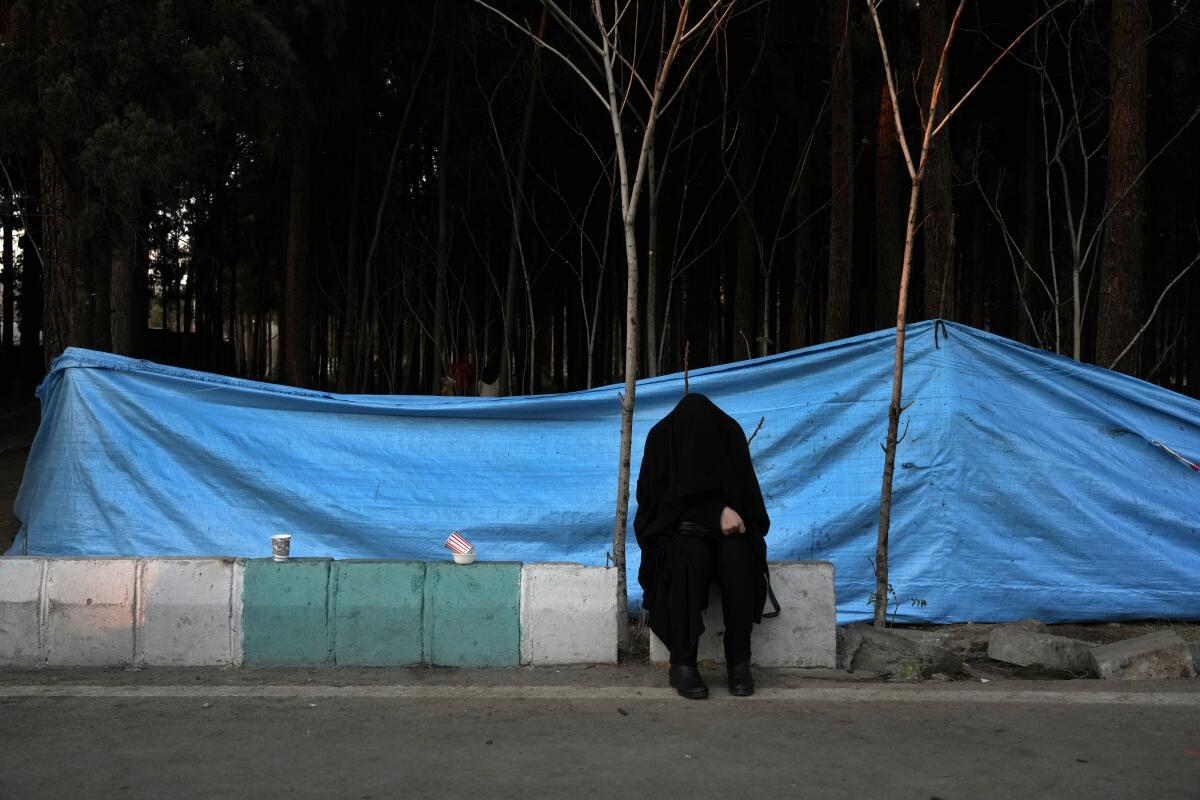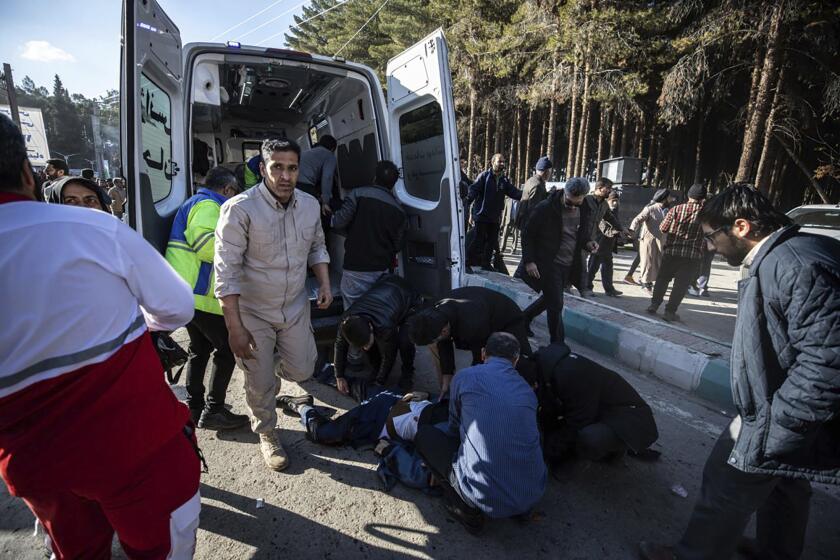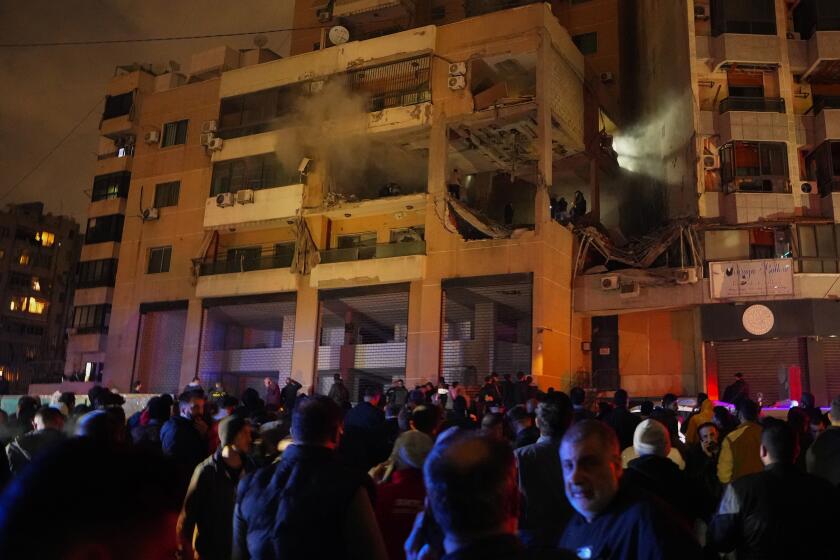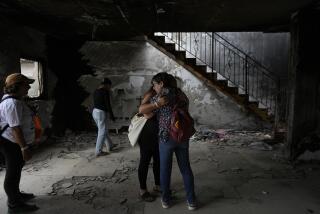Islamic State group claims responsibility for Iran suicide bombings that killed at least 84

- Share via
DUBAI — The Islamic State group claimed responsibility Thursday for two suicide bombings targeting a commemoration for an Iranian general slain in a 2020 U.S. drone strike, the worst militant attack to strike Iran in decades as the wider Middle East remains on edge.
Experts who follow the group confirmed that the statement, circulated online among jihadists, came from the extremists, who likely hope to take advantage of the chaos gripping the region amid Israel’s war on Hamas in the Gaza Strip.
Wednesday’s attack in Kerman killed at least 84 people and wounded an additional 284. It targeted a ceremony honoring Revolutionary Guard Gen. Qassem Suleimani, held as an icon by supporters of the country’s theocracy and viewed by the U.S. military as a deadly foe who aided militants who killed American troops in Iraq.
On Thursday, chunks of asphalt appeared missing from the roadway where one bomb went off, suggesting the bomb had been packed with shrapnel to increase its deadly effects. Another spot still bore congealed blood from the wounded.
“The moment I turned around to tell my husband’s sister, ‘Let’s go to the square,’ the bomb exploded,” 38-year-old Mahdieh Sazmand said from her Kerman hospital bed. “If we were just 10 steps further we would have been right over the bomb.”
The Islamic State group claim identified the two attackers as Omar Mowahed and Seif-Allah Mujahed. The claim said the men carried out the attacks with explosive vests. It also used disparaging language when discussing Shiites, which the Islamic State group views as heretics.
Iran says bombs at an event honoring Gen. Qassem Suleimani, slain in a 2020 U.S. airstrike, have killed at least 95 people and wounded 211 others.
The statement did not mention which regional arm of the extremists carried out the attack, which other claims in the past have had. But Aaron Y. Zelin, a senior fellow at the Washington Institute for Near East Policy, said that some previous claims have not specified the regional arm, and that the latest claim came directly from an account associated with the group.
The group likely hoped to see Iran strike at Israel, widening its war on Hamas into a regional conflict that Islamic State could potentially take advantage of, Zelin said.
“This falls under the modus operandi of IS, especially since it was such a mass casualty attack,” Zelin said. “They are kind of like the Joker. They want to see the world burn. They don’t care how it happens as long as it benefits them.”
The Islamic State group previously claimed a June 2017 attack in Tehran on parliament and a masoleum of Ayatollah Ruhollah Khomeini that killed at least 18 people and wounded more than 50. The group has claimed two other assaults as well.
The extremist group, which once held vast territory across Iraq and Syria in a self-described caliphate it declared in 2014, ultimately were beaten back by U.S.-led forces. It has been in disarray in the years since, though it has mounted major assaults. In neighboring Afghanistan, for instance, the Islamic State group is believed to have grown in strength since the fall of the Western-backed government there to the Taliban in 2021.
The claim came as the extremists separately called on supporters around the world to avenge the bloodshed in the Gaza Strip by attacking Christians and Jews. The group also criticized Palestinian factions for allying with Iran, saying that Tehran only has taken advantage of the situation to appear as the defender of Palestinians.
Iranian government officials did not immediately acknowledge the claim, though state media reported on it. Officials had been indirectly blaming Israel for the attack; in Kerman on Thursday, passersby stepped on signs bearing the image of the Israeli flag with the slogan “Death to Israel” written in Farsi across them.
An earlier report by the state-run IRNA news agency, later aired by state television, quoted an unnamed “informed source” as saying that surveillance video from the route to the commemoration at Kerman’s Matryrs Cemetery clearly showed a male suicide bomber detonating explosives.
The official said the second blast “probably” came from another suicide bomber, though it hadn’t been determined beyond doubt. Authorities plan to hold a mass funeral service Friday for those killed.
Mohammad Mehdi Ghalekhani, a volunteer with the Revolutionary Guards’ Basij force, suffered wounds in an attack he described as being horrific.
What does the killing of a top Hamas commander in an apparent Israeli airstrike in Beirut mean for the war in Gaza between Israel and the Islamic militant group?
“I didn’t get what happened exactly, this happened very suddenly,” he told the AP. “When this happened many people died, and most people where injured. Those who died didn’t have any intact body part — no whole hands or faces.”
The attacks came a day after a deputy head of the Palestinian militant group Hamas was killed in a suspected Israeli strike in Beirut. Another Revolutionary Guard commander was killed in a suspected Israeli airstrike in Syria late last month as well.
Those strikes, as well as attacks on shipping in the Red Sea by Iranian-backed rebels in Yemen known as Houthis, have raised concerns about the Israel-Hamas war escalating into a wider regional conflict.
More to Read
Sign up for Essential California
The most important California stories and recommendations in your inbox every morning.
You may occasionally receive promotional content from the Los Angeles Times.












